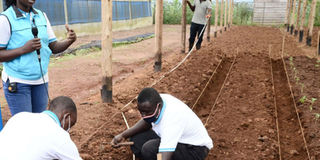Proper land preparation key for vegetable growing

Doreen Nampamya explains how to prepare a garden. PHOTO/GEORGE KATONGOLE
The Covid-19 pandemic has planted roots for the desire for vegetable production. To cultivate your own vegetable garden it is important to prepare the land properly.
During last Saturday’s Seeds of Gold Farm Clinic held at National Agricultural Research Laboratories (NaRL-Kawanda), experts explained that productive organic vegetable gardens are based on a strong foundation, and that foundation is the soil.
Healthy soils provide an environment conducive to root growth which leads to a healthy plant and fruit and vegetable production. Doreen Nampamya, a research associate with Korea Programme on International Agriculture (Kopia), who partners with NaRL explains that the basics for most vegetables are the same.
At Kawanda, where they have demonstration gardens, Kopia supports the growing of tomatoes, Chinese cabbage (pak choi), eggplant, cucumber and cabbage, among others.
The basics
Nampamya explains that for someone willing to start a vegetable business, a low cost screen house is the first investment.
Nampamya says that vegetables are very delicate and thus require shelter. She explains that rain splashes can bring about fungal and soil-borne diseases.
She says that a screen house helps in regulating the temperature while keeping pests especially rodents, and diseases at bay.
A simple screen house can be made from local materials including treated poles. The cover is the most expensive part. Nampamya says the practice of rotating crops in the garden is also a smart tip. This action helps reduce pests and pathogens that may be carried on the same crop from one year to the next.
Nampamya explains that one should start with a soil test in order to know what nutrients are needed as well as the pH and organic content of the soil. “There is no need for guessing, carry out a soil test with accredited laboratories. This helps in determining desired amounts of fertilisers,” she says.
Nampamya says the site for growing vegetables should not be on a steep slope. To manage erosion, vertical ridges should be applied. Farmers can also grow cover crops to prevent run-off.
Land preparation
According to Nampamya, land preparation plays an important role in the quality of vegetables. Land preparation involves opening the desired land. An area that has previously been under use, Nampamya recommends ploughing twice including loosening the soil from the previous crop and then applying manure uniformly.
At Kawanda, the researchers use compost manure. She says farmers can use any manure available to them although she recommends chicken and animal manure mixed with chopped up leaves, grass clippings and cover crops.
These materials are added especially to sandy soils in order to improve water-holding capacity, and added to clay soils to improve drainage. This process takes at least three months for the manure to be fully decomposed.
In an acre, the recommended usage of manure is 10-12 tonnes per acre depending on the particular vegetable. Nampamya says that some vegetables like cabbages require a lot of feeding compared to onions.
After applying manure, the garden should be rested for about two weeks to allow the manure to decompose.
The final preparation for growing vegetables involves preparing ridges which should be made according to the plant spacing. In tomato growing, Nampamya says the ridge should be 8 cm with a 60*60cm spacing. The hole should be 10cm in width to allow the plant feeding space.
Preparing seedlings
Desired seedlings should be hardened by exposing them to direct sunlight six to nine days before transplanting. They should be transplanted late afternoon or on a cloudy day to minimise transplant shock. The seedlings should also be in a 4-5 leaf stage normally for four weeks.
Planting
This is uniquely done by digging a hole. The hole should be watered immediately with enough water. This may not be necessary on a rainy day. She explains that if one did not apply manure during land preparation, fully decomposed manure can be put in the hole and mixed with the soil before planting the seedling.




